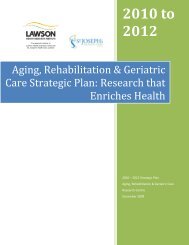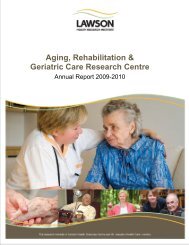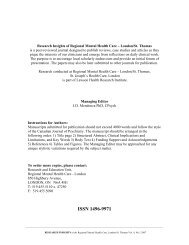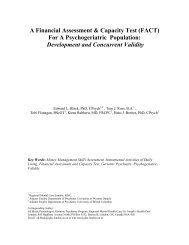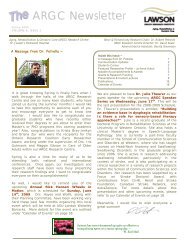REFORMS TO ONTARIO'S MENTAL HEALTH ACT: Lessons from ...
REFORMS TO ONTARIO'S MENTAL HEALTH ACT: Lessons from ...
REFORMS TO ONTARIO'S MENTAL HEALTH ACT: Lessons from ...
- No tags were found...
You also want an ePaper? Increase the reach of your titles
YUMPU automatically turns print PDFs into web optimized ePapers that Google loves.
DECEMBER 2012 | VOL. 9 NO. 3<strong>REFORMS</strong> <strong>TO</strong> ONTARIO’S <strong>MENTAL</strong> <strong>HEALTH</strong> <strong>ACT</strong>:<strong>Lessons</strong> <strong>from</strong> the story of the man who killed Brian SmithRichard O’Reilly, Robert Solomon, John E. Gray
Reforms to Ontario’s Mental Health Act:<strong>Lessons</strong> <strong>from</strong> the story of the man who killed Brian SmithRichard O’Reilly, MB, FRCPCProfessor, Department of Psychiatry, Western University · Canada, London, ONRobert Solomon, LLB, LLMProfessor, Faculty of Law, Western University · Canada, London, ON.John E. Gray, PhDAdjunct Assistant Professor, Department of Psychiatry, Western University · Canada, London, ON.KEY WORDSCommunity Treatment Order; C<strong>TO</strong>; Ontario; Bill 68; Arenburg.Address correspondence to:Dr. Richard O’ReillyRegional Mental Health Care London,St. Joseph's Health Care London,850 Highbury Avenue, PO Box 5532, Stn B,London, ON, Canada N6A 4H1.E-mail: roreilly@uwo.caRESEARCH INSIGHTS of the Regional Mental Health Care London and St. Thomas; Vol. 9, No. 3, 2012
3incident raised questions about both what happened to Arenburg following the killing of Smith and theefficacy of the law named in his memory. Had Arenburg been released <strong>from</strong> the criminal justice systemwithout treatment and adequate supervision? Given that assaulting an armed American customs officer isunlikely to end well for the assailant, who was looking out for Arenburg’s interests? Finally, would thelegislation named after Smith have prevented Arenburg <strong>from</strong> killing Smith?In an attempt to answer these questions, we reviewed Arenburg’s clinical history. In previous work, wedeveloped a method for constructing a clinical profile of individuals with mental illness using informationavailable in the public domain. 6 We anticipated that this method could be used in Arenburg’s case, as hiscase had generated considerable media coverage, and we knew that additional public documents would beavailable <strong>from</strong> the Ontario Review Board. 7The confidentiality obligations of clinicians limit their ability to educate the public, policy makers and thelegal profession about mental illness and its treatment. Given the volume of public information, theArenburg case offers a rare opportunity to provide a detailed description of an individual’s psychiatricillness, how it caused him to act violently and his response to treatment. Our research has also allowed usto examine previous media reports that Arenburg may not have met the criteria for a C<strong>TO</strong> under thelegislation that was named after his victim. 8 On a broader level, Arenburg’s story underscores theimportance of ensuring that mental health reforms actually address the ongoing needs of people withserious mental illness.METHODInformation was drawn <strong>from</strong> several different sources. The court records for Arenburg’s murder trial wereobtained <strong>from</strong> CanLii and LexisNexis. American court records were accessed through the Pacer CaseThe Ottawa Citizen, May 22, 2008, http://www.canada.com/ottawacitizen/news/story.html?id=76d2a4a0-e323-4901-a326-fe43a286ae946 Robert Solomon et al, Treatment Delayed - Liberty Denied, 87:3 Can. Bar. Rev. at 690-91 (2008).7 The Ontario Review Board, like the other provincial review boards, is a quasi-judicial agency that was created in 1992 underthe Criminal Code, R.S.C. 1985, c. C-46 § 672.38 (Can.). Review boards are responsible for supervising suspects who have beenfound “unfit to stand trial” and individuals who have been found “not criminally responsible on account of mental disorder”(NCR) (Id. § 672.38(1)). The Criminal Code requires the review boards to assess each individual at least once a year and theseassessments are generally in the public domain (Id. § 672.81(1)).The Ontario Review Board must be distinguished <strong>from</strong> the Ontario Civil “Review Board” that adjudicated disputes about civilcommitment, treatment and capacity issues under the Mental Health Act. This Ontario Civil Review Board was replaced by the“Consent and Capacity Review Board” in April 1995, which in turn was replaced by the “Consent and Capacity Board” in March,1996. See respectively, Consent and Capacity Statute Law Amendment Act, 1992, S.O. 1992, c. 32, § 20(1) (Can.); and HealthCare Consent Act, 1996, S.O. 1996, Schedule A, § 70(1) (Can.).8 Scott Simmie, When following an order would be wrong, The Toronto Star, October 4, 1998; and Anita Szigeti, OntarioCommunity Treatment Orders: How Did We Get There and Where Do We Go Now? An Advocate’s Perspective, 21 Health L.Can. 66 (2001).RESEARCH INSIGHTS of the Regional Mental Health Care London and St. Thomas; Vol. 9, No.3, 2012
4Locator. We obtained the findings and recommendations of the coroner’s inquest into Smith’s death andthe reports <strong>from</strong> Arenburg’s criminal review board hearings <strong>from</strong> 1997 until 2006. We searched theinternet search engine, Google, using the words “Jeffrey Arenburg” to find media sources. Wherepossible, court, inquest, criminal review board, and civil review board records were used as primarysources of information, and media reports were used as secondary sources.Arenburg’s StoryOur discussion of Arenburg’s story is divided into five time periods: (1) Arenburg’s life prior to his firstpsychiatric hospitalization; (2) Arenburg’s clinical history before he killed Smith; (3) the murder trial; (4)Arenburg’s life under Ontario Review Board supervision; and (5) Arenburg’s life after discharge by thatBoard.1. Arenburg’s Life Prior to his First Psychiatric HospitalizationJeffrey Robert Arenburg was born in 1956 in Bridgewater, Nova Scotia. He completed grade nine andworked in several different jobs including as a fisherman for seven years. 9 When he was thirty years old,Arenburg travelled to Ottawa and attempted to meet Joe Clark (the former Prime Minister of Canada) andBrian Mulroney (the then sitting Prime Minister). Parliamentary security staff identified Arenburg as apotential risk because he was talking about receiving radio broadcasts in his head, and they denied himentry to the Parliament buildings. This is the first reference in the record to Arenburg acting on hispsychotic symptoms. 10In 1989, when Arenburg was thirty-two years old, he fell and suffered a spinal injury which resulted in aresidual disability that necessitated using a cane while walking. He was unable to work and one year laterentered Algonquin College in Ottawa to study materials management. Arenburg was still enrolled at theCollege when he killed Smith. 112. Arenburg’s Clinical History Before he Killed SmithIn July 1990, at the age of thirty-three, Arenburg had his first psychiatric admission. Police broughtArenburg to the South Shore Regional Hospital in Bridgewater, Nova Scotia because he caused adisturbance at the local court house. Arenburg complained that his thoughts were being broadcast foreveryone to hear. He believed that his ex-wife’s family was selling his thoughts to MGM Studios and that9 Arenburg (Re), Ottawa 8732-2475/97, at 2 (Can. Ont. Review Board June 3, 1997) [hereinafter Arenburg (Re), 1997].10 Arenburg (Re), File 2475, at 2 (Can. Ont. Review Board, June 1, 2000) [hereinafter Arenburg (Re), 2000].11 Id.; and Arenburg (Re), 1997, supra note 9, at 2.RESEARCH INSIGHTS of the Regional Mental Health Care London and St. Thomas; Vol. 9, No.3, 2012
5MGM intended to make a movie about them. Arenburg wanted this stopped and demanded that the courtresolve the problem. He said that he had sought out Prime Minister Mulroney the previous year to findout why the court had delayed resolving the issue. Arenburg stated that if the broadcasting of his thoughtsdid not stop, he would burn down the house of his ex-wife’s family or kill someone. 12Arenburg repeated these delusional beliefs while in hospital, but reportedly exhibited no other signs ofmental disorder. Arenburg’s physicians concluded that he had a paranoid psychosis. 13 Arenburg promisedto accept outpatient treatment and demanded to be discharged. He was allowed to leave hospital the dayafter he was admitted. 14In May 1991, Arenburg was admitted to the Royal Ottawa Hospital as an involuntary patient because hewas threatening to harm the staff of the CHEZ radio station. He believed that CHEZ radio staff werebroadcasting his thoughts on the radio, and he threatened to kill someone in order to bring the matterbefore a judge. Arenburg “eloped” <strong>from</strong> the hospital and went to the radio station where he talked about agovernment conspiracy and again threatened to kill the staff. 15 The police were called and returned him tothe hospital.Arenburg applied to the Ontario Civil Review Board, as it was then called, to overturn his involuntaryadmission and the finding that he was incapable of consenting or refusing consent to treatment for hismental illness. Despite being informed of Arenburg’s threats to harm the radio station staff, the CivilReview Board held that he could not be involuntarily detained. However, the Board confirmed thatArenburg was incapable of making treatment decisions. Following the ruling, Arenburg refused to remainin hospital and discharged himself against medical advice. 16 He then returned to Nova Scotia.In October 1991, Arenburg was admitted to the South Shore Regional Hospital in Bridgewater, NovaScotia for the second time. This admission followed a second incident at the local court house. Arenburgbroke windows because he was frustrated that he could not see a judge. He exhibited paranoid delusionssimilar to those he experienced during his previous admissions. Arenburg was transferred to a regional12 Arenburg (Re), No. 1437, para. 4 (Can. Ont. Review Board 2001) [hereinafter Arenburg (Re), 2001].13 Arenburg (Re), 1997, supra note 9, at 3.14 Arenburg (Re), 2001, supra note 12, para. 4.15 Id. para. 6.16 Id.RESEARCH INSIGHTS of the Regional Mental Health Care London and St. Thomas; Vol. 9, No.3, 2012
6psychiatric hospital, where he was held as an involuntary patient and treated with antipsychoticmedication. 17Arenburg’s condition improved somewhat with treatment, but he continued to express delusions about aconspiracy involving court officials and the government. He was noted to have persistent hostility. 18 Afterthree weeks, Arenburg was returned to the South Shore Regional Hospital where he continued to describeauditory hallucinations, bizarre delusions and feelings of resentment about his mistreatment byauthorities. He initially took antipsychotic medication after returning to the South Shore RegionalHospital, but then refused medication and demanded to be discharged. A doctor assessed Arenburg andconcluded that he could not be detained involuntarily. Arenburg left the hospital the next day againstmedical advice. His discharge diagnosis was paranoid schizophrenia. 19Shortly after leaving the hospital, Arenburg attacked the manager of a local radio station. Arenburgbelieved that the radio station was broadcasting the voices that he was hearing. 20 Arenburg was arrestedand charged with assault, but he left Bridgewater and returned to Ottawa before his case came to trial.From 1991 to 1994 he travelled back and forth <strong>from</strong> Ottawa to Bridgewater. In Ottawa, he triedunsuccessfully to meet with the new Prime Minister, Jean Chretien. In Bridgewater, he complained to thelocal sheriff about radio waves. 21When Arenburg returned to Nova Scotia in 1994, he was arrested on the outstanding assault charge. Eventhough Arenburg spoke incoherently at his trial about the radio waves, no psychiatric assessment wasrequested. Arenburg was convicted of assault and placed on probation. Apparently “the court recognizedthat his antisocial behaviour had been directly related to his illness and it was assumed that psychiatriccare would follow with him being placed on probation. Unfortunately, that did not occur.” 22 Arenburgwent back to Ottawa, bringing with him a .22 calibre rifle. 2317 Arenburg (Re), 1997, supra note 9, at 3.18 Id.19 Arenburg (Re), File 2475, at 4 (Can. Ont. Review Board May 10, 2005) [hereinafter Arenburg (Re), 2005].20 Arenburg (Re), 2001, supra note 12, para. 7.21 Id.22 Arenburg (Re), 1997, supra note 9, at 4.23 Arenburg (Re), 2001, supra note 12, para. 7.RESEARCH INSIGHTS of the Regional Mental Health Care London and St. Thomas; Vol. 9, No.3, 2012
7Arenburg lived in Ottawa where he rented a two-bedroom apartment with a friend and his friend’sgirlfriend. He attended school regularly and “socialized with people he met at school, and went out fordrinks, dinner and sports events.” 24On August 1, 1995, Arenburg drove to the CJOH radio station in Ottawa. When Smith left the building at6:50 p.m., Arenburg fired two shots at Smith using the rifle he had brought <strong>from</strong> Nova Scotia, one ofwhich struck Smith in the forehead. Following the shooting, Arenburg drove away <strong>from</strong> the scene. 25 Thenext morning, Arenburg went to an Ottawa court and turned himself in. The Justice of the Peacedescribed Arenburg as calm, cooperative and in full capacity of his senses. Arenburg was charged withattempted murder. He told the police officers that people did not understand that this was “a civilmatter.” 263. The Murder TrialAfter Smith's death, Arenburg's charge was changed to first-degree murder. The judge remandedArenburg to the Royal Ottawa Hospital for sixty days to obtain a psychiatric assessment, including adetermination of whether Arenburg was fit to stand trial. 27 This issue turns on whether an accused is ableto communicate with his lawyer and to understand the nature, purpose and possible consequences of thecriminal proceedings. 28 Arenburg was found fit to stand trial. 29On September 29, 1995, Arenburg was discharged <strong>from</strong> the Royal Ottawa Hospital and presumablyreturned to jail to await trial. 30 On July 17, 1996, he was again admitted to the Royal Ottawa Hospital fora month. The available records do not indicate what led to this admission. 31Arenburg refused psychiatric treatment during the eighteen months following the homicide, despite beingfloridly psychotic with hallucinations and delusions. 32 On February 17, 1997, a fitness jury agreed withdefence counsel that Arenburg was unfit to stand trial. 3324 Arenburg (Re), 2000, supra note 10, at 3-4.25 Jury Verdict and Recommendations, supra note 3, at 1.26 Id. at 2.27 A court may order an accused to be detained and subjected to a comprehensive psychiatric assessment if there is reason tobelieve that he or she is unfit to stand trial or was mentally ill at the time of the offence (Criminal Code, R.S.C. 1985, c. C-46 §672.11 (Can.)).28 Id. § 2 sub verbo “unfit to stand trial”.29 Jury Verdict and Recommendations, supra note 3, at 2.30 Arenburg (Re), 1997, supra note 9, at 6.31 Id.RESEARCH INSIGHTS of the Regional Mental Health Care London and St. Thomas; Vol. 9, No.3, 2012
8On February 18, 1997, the court ordered that Arenburg be admitted to the Royal Ottawa Hospital andtreated for the limited purpose of attempting to make him fit to stand trial. 34 Arenburg was started on aninjection of a long-acting antipsychotic medication, pipotiazine palmitate. After two months of treatment,Arenburg’s auditory hallucinations were gone. By early April 1997, “he no longer felt justified inshooting Mr. Smith.” 35 As of April 21, 1997, Arenburg was not exhibiting hallucinations or delusions.According to Dr. Bradford, a senior psychiatrist, it was apparent that Arenburg’s schizophrenia was in fullremission. 36Arenburg was returned to court on April 28, 1997 and was found fit to stand trial. With the agreement ofthe Crown and defence, the jury trial began on April 29, 1997 and concluded the next day. Arenburg wasfound not criminally responsible on account of mental disorder (NCR) for first-degree murder. 37 On May1, 1997, the trial judge ordered Arenburg detained at the Royal Ottawa Hospital, pending a hearing anddisposition by the Ontario Review Board. 38When an accused is found to be NCR, the court may make one of three dispositions – an absolutedischarge, a conditional discharge or detention in a hospital. The court must make the least onerous andleast restrictive disposition, taking into consideration the need to protect the public, the accused’s mentalcondition, and his or her reintegration into society and other needs. 39 However, if the court does not makea disposition, the provincial criminal review board is authorized to do so. 40 As indicated, the criminalreview boards are also responsible for the ongoing supervision of accused who are not fit to stand trialand individuals who have been found NCR.32 Arenburg (Re), 2000, supra note 10, at 7. The Health Care Consent Act, 1996, S.O. 1996, Schedule A (Can.) does notauthorize overriding a capable person’s refusal of treatment in these circumstances. Pursuant to § 10(1) of the Health CareConsent Act, 1996, treatment cannot be initiated unless the patient is competent and has consented, or the patient is incompetentand his or her substitute-decision maker has consented. Capacity is defined broadly, and all individuals are presumed to becapable unless there are reasonable grounds to believe otherwise (Id. §§ 4(1), (3)). Presumably, Arenburg’s treatment refusal wasnot overridden during this period because it had not been established that he was incapable.33 Jury Verdict and Recommendations, supra note 3, at 2.34 The Criminal Code does not generally authorize the involuntary treatment of mentally-ill suspects or prisoners (Criminal Code,R.S.C. 1985, c. C-46 § 672.55(1) (Can.)). However, a court may order an accused who is found unfit to stand trial to be detainedand treated without consent for up to 60 days (Id. § 672.58). If the accused’s condition remains unchanged, the criminal trial willbe stayed. However, if the accused’s condition improves and he or she becomes fit to stand trial, the criminal proceedingscontinue as if the fitness issue had never arisen (Id. § 672.28).35 Arenburg (Re), 2000, supra note 10, at 4.36 Id.37 Jury Verdict and Recommendations, supra note 3, at 2.38 Id. at 3.39 Criminal Code § 672.54.40 Id. § 672.47(1).RESEARCH INSIGHTS of the Regional Mental Health Care London and St. Thomas; Vol. 9, No.3, 2012
94. Arenburg’s Life under Ontario Review Board SupervisionWhen the Ontario Review Board convened in June 1997, it ordered Arenburg to be detained at thePenetanguishene Mental Health Centre, a maximum security psychiatric facility. 41 Dr. Bradford wrote inhis report to the Board:“His illness is in remission [for] the first time probably since 1986. There is no questionthat when he was ill, Arenburg was dangerous; he threatened to commit homicide andended up killing a complete stranger in a random killing. There is also no question thatat this time he was floridly psychotic, driven by command hallucinations, and also hadsignificant paranoid persecutory delusional beliefs. ... I would emphasize however thatwhatever disposition is continued, considerable caution and a slow and comprehensiveprocess of psychiatric rehabilitation with Mr. Arenburg [is] necessary”. 42In September 1997, Arenburg was taken off injections of pipotiazine palmitate because of tremor andstiffness. In its place, he was treated with an oral antipsychotic, olanzapine, and was subsequently notedto be brighter and more mobile on the ward. 43 During the five years that Arenburg stayed atPenetanguishene, he continued to take olanzapine and did not experience hallucinations or delusions. 44Arenburg was given increased privileges including community passes. In March 2003, he was released<strong>from</strong> the hospital: first staying at a group home and later in the year moving to live with his brother. 45Despite leaving the hospital, Arenburg reported to the hospital every week and continued to be supervisedby the Ontario Review Board.In May 2005, after eight years under the Ontario Review Board supervision, Arenburg was conditionallydischarged and the reporting requirement was reduced <strong>from</strong> weekly to monthly. 46 Arenburg’s finalOntario Review Board hearing was held in November 2006.At that hearing, Dr. Sheppard, Arenburg’s psychiatrist, stated that if Arenburg stopped takingantipsychotic medication, his psychotic symptoms would likely return within weeks to months. However,41 Jury Verdict and Recommendations, supra note 3, at 3.42 Arenburg (Re), 1997, supra note 9, at 7-8.43 Arenburg (Re), File 0493-2475/98, at 2 (Can. Ont. Review Board 1998) [hereinafter Arenburg (Re), 1998].44 Arenburg (Re), No. 115, para. 10 (Can. Ont. Review Board 2007) [hereinafter Arenburg (Re), 2007].45 Id. paras. 6, 10.46 Arenburg (Re), 2005, supra note 19, para. 3.RESEARCH INSIGHTS of the Regional Mental Health Care London and St. Thomas; Vol. 9, No.3, 2012
10Dr. Sheppard noted that Arenburg continued to respond to a low dose of olanzapine and that Arenburg’streatment team had no concerns about compliance. The treatment team recommended an absolutedischarge. 47The Ontario Attorney General retained a second psychiatrist, Dr. Klassen, to provide an independentassessment of Arenburg’s mental state and risk to the public. Dr. Klassen concluded that Arenburg wouldlikely take his medication after discharge and that he was not a significant risk to others. 48Mr. Russell, counsel for the Attorney General, opposed an absolute discharge because of the risk to thepublic. He recommended that Arenburg remain on a conditional discharge order, but be subjected to areduced reporting obligation. He contended that:“The risk arises because if the accused stops his medication, there will be anemergence of delusions, and that could lead to someone being killed as occurred in theindex offence. … [A]n absolute discharge would put the accused back into the sameposition he was prior to the index offence, and at that time, the accused was rejectingpsychiatric treatment, was not on medication and was overtly psychotic in a mannerthat lead [sic] to the death of Mr. Smith”. 49Mr. Russell submitted that this risk was so high as to constitute a foreseeable and real risk.The Ontario Review Board found no evidence to conclude that Arenburg was a significant risk to thepublic. The Board noted that Arenburg had been receiving new antipsychotic medication and had beenfree of symptoms for approximately nine years and granted him an absolute discharge. The granting of anabsolute discharge ended Arenburg’s obligation to accept any treatment or monitoring.5. Arenburg’s Life after Being DischargedOn November 29, 2007, one year after his absolute discharge, Arenburg was arrested for assaulting anAmerican customs officer at the Peace Bridge in Fort Erie, Ontario. Arenburg did not have validdocumentation to enter the US and was referred for a secondary inspection. When the officer attempted toconduct a “pat down” search, Arenburg punched him in the face. 5047 Arenburg (Re), 2007, supra note 44, paras. 10, 14-15.48 Id. para. 18.49 Id. para. 22.50 United States v. Arenburg, W.L. 3286444, at 1 (W.D.N.Y. 2008).RESEARCH INSIGHTS of the Regional Mental Health Care London and St. Thomas; Vol. 9, No.3, 2012
11Unfortunately, there are few details about Arenburg’s life in the year between his absolute dischargeand his arrest at the border. We do know that Arenburg had attempted to enter the United States earlierin the month, but was denied entry because he did not have the necessary documents. 51The American prosecutors believed that Arenburg had stopped taking antipsychotic medication beforethe assault, 52 despite Arenburg’s claims to the contrary. 53 Arenburg initially said that the incident had“nothing to do with hearing voices in my head.” 54 However, he subsequently stated, “I'm not saying Ididn't hit the man, I'm saying they're guilty of hiding the microwave channel in my name.” Arenburgstated in court that he was cured of paranoid schizophrenia: “I’ve worked my way out of it.” 55A forensic psychologist who assessed Arenburg reported that his paranoid schizophrenia was inremission. The psychologist also stated that Arenburg was fit to stand trial and was capable ofappreciating the wrongfulness of the assault on the officer. 56However, Arenburg’s subsequent behaviour in court raised doubts about his fitness and generatedlegal proceedings that continued long after his initial trial. 57 In a letter to the court read at hisindictment on April 3, 2008, Arenburg referred to “radio stations airing my thoughts all over theworld … through TV channels.” 58 During the trial, Arenburg was preoccupied with trying to confirmthat there was a conspiracy to broadcast his thoughts.Despite the trial judge’s reservations, Arenburg dismissed his lawyer and chose to represent himself. Inhis opening statement, Arenburg told the jury that he was “going to prove that MGM [Studios] is hidingthe illegal drug trade in my name through the radio stations that you can call up or they can call you to51Jackson Hayes & Josh Wingrove, Journalist’s killer arrested again, The Toronto Star, December 3, 2007,http://www.thestar.com/news/gta/article/281990--journalist-s-killer-arrested-again .52Arenburg lawyer ponders insanity defence, The Ottawa Citizen, February 8, 2008,http://www.canada.com/story.html?id=4d0c51ba-dfdf-4755-b2e5-09c0ca180645 [Lawyer ponders].53Arenburg insists he was taking medication when he assaulted guard, The Ottawa Citizen, September 9, 2008,http://www.canada.com/ottawacitizen/news/story.html?id=5fa6d8d3-00fc-482e-9ac8-137c224de383 .54 Lawyer ponders, supra note 52.55Arenburg found guilty of assaulting officer, The Ottawa Citizen, May 22, 2008,http://www.canada.com/ottawacitizen/news/story.html?id=76d2a4a0-e323-4901-a326-fe43a286ae94 [Arenburg found guilty].56 US v Arenburg, 2008, supra note 50.57 The final appeal on the issue of whether Arenburg had been competent to represent himself concluded on May 25, 2010, abouteight months after he had served his sentence and was deported to Canada. United States v. Arenburg, 605 F.3d 164 (2d Cir.2010).58 United States v. Arenburg, W.L. 3286444, at 2 (W.D.N.Y 2008).RESEARCH INSIGHTS of the Regional Mental Health Care London and St. Thomas; Vol. 9, No.3, 2012
12tell people how to treat me or to find out about me because of MGM.” 59 He questioned governmentwitnesses about secret broadcasts, which he called the “microwave channel”, claiming that they begantwenty years ago after he called a radio station and talked “into a blank tape.” He claimed that a majormovie studio was turning his thoughts into films and accused the government of trying to cover this up. 60On May 21, 2008, the jury found Arenburg guilty of assaulting a federal customs officer. Arenburg wassentenced to two years imprisonment and ordered deported upon release. On September 6, 2009, nearlytwo years after the assault, Arenburg was released <strong>from</strong> prison and deported to Canada.DISCUSSIONLegislative ReformThe coroner’s jury in the inquest into Brian Smith’s death made seventy-two recommendations. Partly inresponse to these recommendations, the Ontario government proclaimed in force An Act, in memory ofBrian Smith, to amend the Mental Health Act and the Health Care Consent Act, 1996. 61 Brian’s Law, as itis commonly called, broadened the involuntary admission criteria and introduced C<strong>TO</strong>s. We will reviewwhether these two key amendments would likely have prevented Smith’s death.Prior to Brian’s Law, Ontario’s Mental Health Act restricted involuntary admission to individuals whowere suffering <strong>from</strong> a mental disorder that was likely to result in: serious bodily harm to the patient;serious bodily harm to another person; or imminent and serious physical impairment of the patient.Brian’s Law eliminated the immanency for serious physical impairment of the patient, but left the othertwo criteria unchanged. 62In addition, Brian’s Law introduced a new ground for involuntary admission based on a history of mentalillness that, when not treated, posed a risk of serious bodily harm, substantial mental or physicaldeterioration, or serious physical impairment. 63 Section 20(1.1) of the Mental Health Act 64 authorizesphysicians to invoke this provision if they are of the opinion that the patient:59 See Arenburg, 605 F.3d, at 4.60 Arenburg found guilty, supra note 55.61 Brian's Law (Mental Health Legislative Reform), 2000, S.O. 2000, c. 9 (Can.).62 Id. § 6(4).63 Id. § 7(2).64 Mental Health Act, R.S.O. 1990, c. M.7 (Can.).RESEARCH INSIGHTS of the Regional Mental Health Care London and St. Thomas; Vol. 9, No.3, 2012
13(a) has previously received treatment for a mental disorder of an ongoing or recurring nature that,when not treated, is of a nature or quality that likely will result in serious bodily harm to the personor to another person or substantial mental or physical deterioration of the person or seriousphysical impairment of the person;(b) has shown clinical improvement as a result of the treatment;(c) is apparently suffering <strong>from</strong> the same mental disorder as the one for which he or she previouslyreceived treatment or <strong>from</strong> a mental disorder that is similar to the previous one;(d) is likely to cause serious bodily harm to him or herself or others, or is likely to suffer substantialmental or physical deterioration or serious physical impairment;(e) is incapable, within the meaning of the Health Care Consent Act, 1996 65 of consenting to his or hertreatment in a psychiatric facility and the consent of his or her substitute decision-maker has beenobtained; and(f) is not suitable for admission or continuation as an informal or voluntary patient.Subsections (a), (b) and (c) restrict this new basis for involuntary admission to individuals who receivedtreatment for a recurring mental disorder that had previously responded to treatment. Subsection (d)introduces a new factor in the involuntary admission criteria, namely a patient’s substantial mental orphysical deterioration. It is the addition of this “deterioration” factor that broadens the pre-existinginvoluntary admission criteria. Subsection (e), which requires the substitute decision maker’s consent totreatment, ensures that incapable patients who are involuntarily detained can be treated. Presumably,subsection (e) was added because, unlike the legislation in some other provinces, 66 the MHA does notauthorize the treatment of involuntary patients without their consent or that of their substitute decisionmaker. 67The introduction of a deterioration criterion for involuntary commitment has played an important role infacilitating the use of C<strong>TO</strong>s, the second major change under Brian’s Law. 68 To be placed on a C<strong>TO</strong>,Brian’s Law requires that the patient meet the provincial involuntary inpatient committal criteria.However, physicians are likely to be reluctant to place a person on a C<strong>TO</strong> and treat that person in acommunity setting if they have assessed the person as posing a risk of physical harm to themselves or to65 Health Care Consent Act, 1996, S.O. 1996, Schedule A, § 4 (Can.); See also supra note 7.66 See for example, section 31(1) of the Mental Health Act, R.S.B.C 1996, c.288 (Can.).67 See for example, Starson v. Swayze (2003), 225 D.L.R (4th) 385 (Can. S.C.C); Neto v. Klukach (2004), 12 Admin. L.R. (4th)101 (Can. Ont. Sup. Ct. J.).68 Brian's Law (Mental Health Legislative Reform), 2000, S.O. 2000, c. 9 (Can.).RESEARCH INSIGHTS of the Regional Mental Health Care London and St. Thomas; Vol. 9, No.3, 2012
14others. Physicians are more comfortable treating patients in community settings when the identified risk ismental or physical deterioration - which can presumably be prevented by mandatory supervision andtreatment. 69In addition to meeting the involuntary committal criteria, a person being placed on a C<strong>TO</strong> for the firsttime must have been admitted to an Ontario psychiatric facility on two separate occasions, or have acumulative period of hospitalization totalling thirty days or more within the previous three years.Although Ontario introduced C<strong>TO</strong>s in response to Brian Smith’s death, it is ironic that Arenburg wouldnot have met the statutory requirements for a C<strong>TO</strong> before he killed Smith for two reasons. First, Arenburgwould not have met the C<strong>TO</strong> requirement for two previous hospitalizations in Ontario. Arenburg wasadmitted to an Ontario psychiatric unit only once – not twice as required by Brian’s Law. That singleadmission was to the Royal Ottawa Hospital <strong>from</strong> May 16 to June 11, 1991, a period of twenty-six days -less than the thirty days required by Brian’s Law. While Arenburg had been admitted previously in NovaScotia, these admissions occurred out of province and would not have counted toward the requirementsunder Ontario law.Second, when Arenburg was hospitalized in Ontario, the Ontario Civil Review Board held that he did notmeet the criteria for involuntary admission, and therefore could not have been placed on a C<strong>TO</strong> at thetime of his discharge <strong>from</strong> hospital. 70 Moreover, Arenburg would not have met Ontario’s broadenedcommittal criterion, introduced under Brian’s Law. Apparently, Arenburg did not undergo any psychiatrictreatment during or after his first psychiatric admission in Nova Scotia, which lasted for a single day.Treatment with antipsychotic medication requires at least several days to take effect. Therefore, therewould have been no evidence that Arenburg’s mental disorder had previously responded to treatment, asrequired by the amended involuntary admission criteria. 71Nor would Arenburg have qualified for a C<strong>TO</strong> under Nova Scotia’s 2007 legislation. He would not havesatisfied Nova Scotia’s previous psychiatric hospitalization requirements, namely a minimum of sixtydays or two admissions within the previous two years. 72 These are even more restrictive than Ontario’s69 The limited research on this topic indicates that most C<strong>TO</strong>s are based on a risk of mental or physical deterioration. See Ann-Marie O’Brien, Dangerousness or Deterioration: What Criteria are Psychiatrists Using to Issue C<strong>TO</strong>s? Paper delivered at the31st International Congress on Law and Mental Health, New York, NY. June 28, 2009 – July 3, 2009,http://www.ialmh.org/template.cgi?content=NewYork2009/main.html at 143.70 Arenburg (Re), 2001, supra note 12, at para 6.71 Mental Health Act, R.S.O. 1990, c. M.7, § 20(1.1)(a)-(b) (Can.).72 Involuntary Psychiatric Treatment Act, S.N.S. 2005, c.42, § 47(3)(a)(iv) (Can.).RESEARCH INSIGHTS of the Regional Mental Health Care London and St. Thomas; Vol. 9, No.3, 2012
15requirements. Moreover, as in Ontario, to be eligible for a C<strong>TO</strong> in Nova Scotia a person must first meetthe requirements for involuntary admission. 73 During both of Arenburg’s admissions in Nova Scotia,physicians concluded that he was not certifiable and allowed Arenburg to discharge himself.It is generally accepted that mental health statutes should impose the least restrictive conditions on theliberty of the individual. 74 Indeed, the Ontario Mental Health Act explicitly adopts this principle, statingthat: “[t]he purpose of a community treatment order is to provide a person who suffers <strong>from</strong> a seriousmental disorder with a comprehensive plan of community-based treatment or care and supervision that isless restrictive than being detained in a psychiatric facility.” 75Since C<strong>TO</strong>s are less restrictive than inpatient committals, it is illogical to impose more stringentqualification requirements on C<strong>TO</strong>s than on involuntary admissions. Yet, this is exactly what Ontario hasdone by limiting C<strong>TO</strong>s to patients who meet a prior hospitalization requirement in addition to theinvoluntary committal criteria. Moreover, as Table 1: Requirements for Involuntary Admissions andCommunity Treatment Orders in Ontario 76 illustrates, Ontario has imposed several other limits onqualifying for C<strong>TO</strong>s that are not required for involuntary admissions.73 Id. §§ 17, 47(3)(a).74 Richard L. O’Reilly et al, Principles Underlying Mental Health Legislation, 55:10 Can. J. Psychiatry P1 (2010); Chih-YuanLin, Ethical Exploration of the Least Restrictive Alternative, 54:6 Psychiatr. Serv. 866 (2003).75 Mental Health Act, R.S.O. 1990, c. M.7, § 33.1(3) (Can.).76 Id. §§ 20, 33.1.RESEARCH INSIGHTS of the Regional Mental Health Care London and St. Thomas; Vol. 9, No.3, 2012
16TABLE 1: Requirements for Involuntary Admissions and Community Treatment Orders inOntario 76ISSUE INVOLUNTARY ADMISSIONS COMMUNITY TREATMENT ORDERSPurpose Not stated “Provide a comprehensive plan of community-basedcare and supervision that is less restrictive than beingdetained in a psychiatric facility”Presence of a YesYesMental DisorderRisk RequirementPriorHospitalizationConsentRegardingTreatmentRisk of serious bodily harm ORsubstantial mental or physicaldeteriorationNot requiredNot required if committal is basedon dangerousness criteria, butrequired if committal is based ondeterioration criteriaRisk of serious bodily harm OR substantial mental orphysical deteriorationMust have two or more separate admissions or a totalof >30 days in hospital in previous 3 yearsConsent required <strong>from</strong> the patient (if capable) or <strong>from</strong>the substitute decision maker (if the patient isincapable)Treatment Plan Not required Physicians must develop a treatment plan with thepatient (if capable) or their substitute decision maker(if incapable) and other clinicians involved in thepatient’s treatment or supervisionDuration 3-month maximum (renewable) 6-months maximum (renewable)DischargeCriterionPatient no longer meets any of thecriteriaPatient no longer meets any of the criteria or theoriginal consent is withdrawnSome scholars have argued that C<strong>TO</strong>s are no less restrictive than involuntary hospitalization. 77 Thesescholars note that patients may remain on the C<strong>TO</strong>s for extended periods of time, whereas most inpatienthospital care is only available for short periods of time. 78 Therefore, while the locus of treatment andsupervision under a C<strong>TO</strong> is less restrictive, the deprivation of liberty may be for a longer period of time.Ultimately, patients must weigh the importance of duration of compulsory supervision and treatmentversus locus of treatment in determining whether inpatient or outpatient committal is least restrictive. Theexisting research data, albeit limited, indicate that patients view C<strong>TO</strong>s as less restrictive. When patients,suffering <strong>from</strong> schizophrenia, were asked whether they would prefer to be involuntarily hospitalized orplaced on a C<strong>TO</strong>, they overwhelmingly chose placement on a C<strong>TO</strong>. 79 Moreover, a similar preference forcompulsory treatment in the community, rather than hospitalization has been reported by patients inqualitative research studies. 8077 Shelley Trueman, Community Treatment Orders and Nova Scotia: The Least Restrictive Alternative? 11:1 Health L.J. at 16-20(2003).78 Delphine Capdevielle & Karen Ritchie, The Long and the Short of It: Are Shorter Periods of Hospitalisation Beneficial?, 192:3Br. J. Psychiatry 164 (2008). [The Long and the Short of It].79 Marvin S. Swartz et al, Assessment of Four Stakeholder Groups’ Preferences Concerning Outpatient Commitment for Personswith Schizophrenia, 160:6 Am. J. Psychiatry 1139 (2003).80 Anita Gibbs et al, How Patients in New Zealand View Community Treatment Orders, 14:4 J. Ment. Health 357 (2005); RichardL. O’Reilly et al, A Qualitative Analysis of the Use of Community Treatment Orders in Saskatchewan, 29:6 Int. J. Law PsychiatryRESEARCH INSIGHTS of the Regional Mental Health Care London and St. Thomas; Vol. 9, No.3, 2012
17As is the case in Ontario, three of the remaining provinces with C<strong>TO</strong>s (Saskatchewan, Nova Scotia, andNewfoundland and Labrador) have a prior hospitalization requirement. In contrast, Alberta’s legislationprovides that a C<strong>TO</strong> may be issued if the person has been in an approved hospital, or “lawfully detainedin a custodial institution” and two physicians agree that while there he or she would likely have met theinvoluntary admission criteria. 81 The Act also provides an alternative criterion whereby a person may beplaced on a C<strong>TO</strong> if he or she “exhibited a pattern of recurrent or repetitive behaviour that indicates thatthe person is likely to cause harm to the person or others or to suffer substantial mental or physicaldeterioration or serious physical impairment if the person does not receive continuing treatment.” 82The eight Australian jurisdictions with C<strong>TO</strong>s do not require prior hospitalization. 83 Nor do most of theforty-four US states that have legislated C<strong>TO</strong>s. 84 New Zealand’s legislation not only eschews the needfor prior hospitalization, it explicitly directs that the less restrictive option must be followed. When a NewZealand court determines that a person meets the civil commitment criteria, the legislation directs that thecourt “shall make a community treatment order unless the court considers that the patient cannot betreated adequately as an outpatient, in which case the court shall make an inpatient order”. 85Purpose of C<strong>TO</strong>sWhether the C<strong>TO</strong> legislation includes a prior hospitalization requirement partially reflects differentrationales for introducing C<strong>TO</strong>s. A review of the literature suggests that the major purposes of C<strong>TO</strong>legislation are to:(a)(b)(c)(d)provide a less restrictive alternative to involuntary inpatient hospitalization;reduce the “revolving door” phenomenon;reduce harm to members of the public; andmaximize the potential for patient recovery.524 (2006); Krysia Canvin et al, A ‘Bittersweet Pill To Swallow: Learning <strong>from</strong> Mental Health Service Users’ Responses ToCompulsory Care in England, 10:5 Health Soc. Care Community 361 (2002).81 Mental Health Act, R.S.A. 2000, c.M-13, § 9.1(1)(b)(i)(B)-(C) (Can.).82 Id. § 9.1(1)(b)(iii).83 John Ellery Gray et al, Australian and Canadian Mental Health Acts Compared, 44:12 Aust. N. Z. J. Psychiatry 1126 (2010).84 The majority of the US states that require prior hospitalization use a lower standard for outpatient as opposed to inpatientcommittal. See Assisted Psychiatric Treatment: Inpatient and Outpatient Standards by State, Treatment Advocacy Center (June2011), http://www.treatmentadvocacycenter.org/storage/documents/new_the_updated_state_standards_chart.pdf85 Mental Health (Compulsory Assessment and Treatment) Act 1992, SR 1992/46, § 28(2) (N.Z.).RESEARCH INSIGHTS of the Regional Mental Health Care London and St. Thomas; Vol. 9, No.3, 2012
18As indicated, the Ontario legislation states that the purpose of a C<strong>TO</strong> is to provide “…a comprehensiveplan of community-based treatment or care and supervision that is less restrictive than being detained ina psychiatric facility.” 86 However, the section then focuses on the typical revolving door patient:“Without limiting the generality of the foregoing, a purpose is to provide such a plan fora person who, as a result of his or her serious mental disorder, experiences this pattern:The person is admitted to a psychiatric facility where his or her condition is usuallystabilized; after being released <strong>from</strong> the facility, the person often stops the treatment orcare and supervision; the person’s condition changes and, as a result, the person must bere-admitted to a psychiatric facility.” 87The phrase “[w]ithout limiting the generality of the forgoing …” clearly indicates that addressing theneeds of revolving door patients is only one of the purposes of the C<strong>TO</strong> provisions. Rather, the lessrestrictive community-based treatment option provided by C<strong>TO</strong>s should be available to all patients whomeet the statutory criteria. The prior hospitalization requirement conflicts with the broader goals of C<strong>TO</strong>sby restricting their use to people who have at least started the revolving door pattern.Naming the legislative amendments in Brian Smith’s memory adds to this confusion by suggesting thattheir primary purpose is to protect the public. However, the policy debate preceding the introduction ofC<strong>TO</strong>s shows that their main proponents (family members represented by the Schizophrenia Society ofOntario and psychiatrists represented by the Ontario Medical Association) advocated for C<strong>TO</strong>s as a wayof ensuring that patients received continued treatment and supervision so as to maximize their potential. 88The Ontario experience of a government publically portraying C<strong>TO</strong>s as a means of reducing the risk ofviolence is not unusual. In several other jurisdictions, a random act of violence by a person with a mentalillness was the final catalyst for legislative action, with legislation being named in the victim’s memory. 89In our view, this approach unduly emphasizes the link between mental illness and violence, and isunnecessarily stigmatizing. While people with severe mental illness are more likely than other members86 Mental Health Act, R.S.O. 1990, c.M.7, § 33.1(3) (Can.).87 Id.88Community Treatment Orders: Is Patient Freedom Being Violated?, Network. 14:2 4, at 6,8 (Summer 1998),http://www.ontario.cmha.ca/network.asp?cID=1367.89 In addition to Brian’s Law (Mental Health Legislative Reform), 2000, S.O. 2000, c. 9 (Can.), see in New York Kendra’s Law,N.Y. Mental Hyg. Law § 9.60 (2006); and in California, Laura’s Law, Cal. Welf. & Inst. Code §§ 5345-5349.5 (West Supp.2007).RESEARCH INSIGHTS of the Regional Mental Health Care London and St. Thomas; Vol. 9, No.3, 2012
19of the public to perpetrate violent acts, 90 serious assaults and homicides involving strangers are rare 91 andhard to predict. 92While the reduction of serious violence is unlikely to be the primary benefit of C<strong>TO</strong>s for the reasonsoutlined above, there is evidence that C<strong>TO</strong>s do reduce violent behaviour. 93 Moreover, we argue thatArenburg’s history of threats and physical violence caused by delusions, coupled with the failure to treatthese delusions, made further violence entirely predictable. Arenburg’s subsequent clinical history showsthat when he received sustained treatment with antipsychotic medication, his symptoms fully remitted.Moreover, Arenburg’s psychotic symptoms only returned when he apparently stopped his medication.Therefore, it is difficult not to conclude that Smith’s life could have been saved, and Arenburg’s lifecould have been much less restricted, had he received appropriate psychiatric treatment earlier.So what treatment did Arenburg need? Patients with psychotic illnesses, such as schizophrenia, startshowing improvement in their hallucinations and delusions after several days of antipsychotic treatment. 94However, complete resolution of symptoms sometimes takes up to eight weeks of treatment, 95 and somepatients do not recover fully. The development of insight - awareness that the hallucinations anddelusions are a product of illness - may require many months of additional treatment and again for manypatients, full insight is never achieved. 96 A course of sustained treatment could have been administeredduring any one of Arenburg’s three hospital admissions before he killed Smith. This did not happen ontwo admissions because a physician discharged Arenburg despite his recent threats to harm others and the90 Although this conclusion is still occasionally challenged in the literature, most scholars have accepted that there is anassociation. Prominent researchers, such as Professor John Monahan, who at one point had argued against an association, issued aconsensus statement with mental health advocates acknowledging the association in 1994 (John Monahan & Jean Arnold,Violence by People with Mental Illness: A Consensus Statement by Advocates and Researchers, 19:4 Psychiatr, Rehabil. J. 67(1996)).Subsequent methodologically rigorous studies have confirmed the association. Overall, the association is modest and strongeramong females than among male offenders. It is also stronger in cases of homicides as opposed to less severe violence (PatriciaA. Brennan et al, Major Mental Disorders and Criminal Violence in a Danish Birth Cohort, 57:5 Arch. Gen. Psychiatry 494(2000)); Seena Fazel et al, Schizophrenia and Violence: Systematic Review and Meta-Analysis, 6(8):e 1000120. PLoS Med.(Epub August 11, 2009)).91 Olav Nielssen et al, Homicide of Strangers by People with a Psychotic Illness, 37:3 Schizophr. Bull. 572 (2011).92 Jeffrey Swanson, Explaining Rare Acts of Violence: The Limits of Evidence <strong>from</strong> Population Research 62:11 Psychiatr. Serv.1369 (2011).93 Bruce G. Link et al, Arrest Outcomes Associated with Outpatient Commitment in New York State, 62:5 Psychiatr. Serv. 504(2011).94 Drugs and Other Physical Treatments, in Michael Gelder, Paul Harrison, & Philip Cowen, eds, Shorter Oxford Textbook ofPsychiatry, 5 th ed (Oxford, UK: Oxford University Press, 2006) 539 at 517-576.95 Robin Emsley et al, Time Course for Antipsychotic Treatment Response in First-Episode Schizophrenia, 163:4 Am. J.Psychiatry 743 (2006).96 Faith B. Dickerson et al, Lack of Insight Among Outpatients with Schizophrenia, 48:2 Psychiatr. Serv. 195 (1997).RESEARCH INSIGHTS of the Regional Mental Health Care London and St. Thomas; Vol. 9, No.3, 2012
20continued presence of psychotic symptoms. The Ontario Civil Review Board also overturned Arenburg’sinvoluntary hospitalization in very similar circumstances.Based on the information in the public record, it is our view that Arenburg could have been detained atthe time of those admissions under the existing Nova Scotia and Ontario mental health acts. It is possiblethat the Ontario Review Board documents, upon which we relied, omitted important details thatconvinced his doctors and the Civil Review Board that he did not meet the committal criteria on theseoccasion. However, it is difficult to understand how anything, short of factual error in the Ontario ReviewBoard records, could satisfactorily explain why Arenburg was only hospitalized for one day after his firstadmission in Nova Scotia when he threatened to kill somebody as a result of his hallucinations anddelusions.We suspect that the shortage of inpatient psychiatric beds, brought about by the ongoing process ofdeinstitutionalization, influenced at least some of these decisions not to treat Arenburg in hospital for alonger period. Other scholars have noted that the application of committal criteria is dependent on theavailability of psychiatric beds. 97 They have also questioned whether deinstitutionalization has reducedthe number of available beds to levels where patients who pose a serious risk to themselves or others areeither not admitted or are discharged prematurely. 98Regardless of whether deinstitutionalization has gone too far, there is little likelihood that the next decadewill see a reversal in the trend to reduce the number of psychiatric beds. The development of C<strong>TO</strong>legislation is a direct result of deinstitutionalization, which necessitated having to treat in the communitypatients who lack insight and develop dangerous behaviours when ill.CONCLUSIONClinicians are now required to manage individuals with serious mental illnesses who have no appreciationof their need for treatment in community settings. In many cases, this can only be safely achieved byemploying some form of compulsory community treatment scheme. The details of the C<strong>TO</strong> legislationare critical in determining its effectiveness. Complex and restrictive C<strong>TO</strong> legislation tends to be ignoredby clinicians. 99 The absence of, or failure to use, C<strong>TO</strong> legislation will leave people like Arenburg97 Nancy B. Engleman et al, Clinicians' Decision Making about Involuntary Commitment, 49:7 Psychiatr. Serv. 941 (1998).98 Povl Munk-Jorgensen, Has Deinstitutionalization Gone Too Far?, 249:3 Eur. Arch. Psychiatry Clin. Neurosci. 136 (1999);The Long and the Short of It, supra note 78.99 John Dawson, Fault-lines in Community Treatment Order Legislation, 29:6 Int. J. Law Psychiatry 482 (2006); AnitaWandzura, Community Treatment Orders in Saskatchewan: What Went Wrong? 71:2 Sask. L. Rev. 269 (2008).RESEARCH INSIGHTS of the Regional Mental Health Care London and St. Thomas; Vol. 9, No.3, 2012
21unsupervised and untreated in the community. This will have serious consequences both for that personand for the public. We argue that it is illogical to make the C<strong>TO</strong> requirements more stringent than thosefor involuntary admission. More specifically, we recommend that prior hospitalization should not be arequirement of C<strong>TO</strong> statutes that require a person to meet the jurisdiction’s inpatient committal standards.ACKNOWLEDGEMENTThis study was supported by funding <strong>from</strong> the Department of Psychiatry and the Faculty of Law atWestern University, London, Ontario. We greatly appreciate the assistance of Joanne Chapman, JordanSchubert and Ailbish Skinner in preparing the manuscript.RESEARCH INSIGHTS of the Regional Mental Health Care London and St. Thomas; Vol. 9, No.3, 2012



